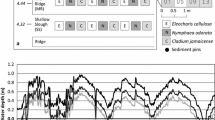Abstract
In a typical Dutch polder landscape the effects of nutrient transport from cultivated grassland to mesotrophic fen communities were studied. In a comparative approach, biomass production and nutrient (N, P and K) uptake were determined monthly in four fens and a hayfield differeing in productivity and species composition. The interstitial ground water was sampled every two weeks for determinations of inorganic nutrient concentrations.
The differences in productivity between the fens were clearly reflected in the amount of N, P and K taken up in the above-ground vegetation. N and P proved to be limiting plant growth in the fens, whereas K was the main limiting factor in the hayfield. The ground water welling up from the sandy bottom into the fens proved to be rich in ammonia (3–5 ppm). There are strong indications that this continual seepage leads to a considerable input of N into the fens but not to a higher productivity, as the ammonia is absorbed by the lowermost peat layers covering the sand.
At this moment, the differences in productivity between the fens must be caused by differences in the rates of mineralization of the superficial peat layer. The degree of fixation of the floating vegetation mat, determining whether or not low water levels lead to an aerated soil top layer, is important in this respect. Within a period of decades, however, the continuous inflow of ammonia may eventually cause an increase in the productivity and a change in the species composition of the fens.
Similar content being viewed by others
References
Al-Mufti M, Sydes CL, Furness SB, Grime JP, Band SR (1977) A quantitative analysis of shoot phenology and dominance in herbaceous vegetation. J Ecol 65:759–791
De Jong J (1976) The purification of wastewater with the aid of rush or reed ponds. In: Biological control of water pollution. Philadelphia, pp 133–139
Gaudet JJ (1977) Uptake, accumulation and loss of nutrients by Papyrus in tropical swamps. Ecology 58:415–422
Godshalk GL, Wetzel RG (1978a) Decomposition of aquatic angiosperms. II. Particulate components. Aqua Bot 5:301–327
Godshalk GL, Wetzel RG (1978b) Decomposition of aquatic angiosperms. III. Zostera marina and a conceptual model of decomposition. Aquat Bot 5:329–354
Gosselink JG, Turner RE (1978) The role of hydrology in freshwater wetland ecosystems. In: Freshwater wetlands. Ecologicl processes and managemnt potential. Good RE, Whigham DF, Simpson RL (eds) Academic Press, New York, pp 63–78
Grime JP (1979) Plant strategies and vegetation processes. Wiley, Chichester, pp 222
Isotalo A (1951) Studies on the ecology and physiology of cellulosedecomposing bacteria in raised bogs. Acta Agr Fenn 74:pp 106
Moizuk GA, Livingston RB (1966) Ecology of red maple (Acer rubrum L.) in a Massachusetts upland bog. Ecology 47:942–950
Parma S (1980) The history of the eutrophication concept and the cutrophication in The Netherlands. Hydrobiol. Bull Amsterdam 14:5–12
Parnas H (1975) Model for decomposition of organic material by micro-organisms. Soil Biol Biochem 7:161–169
Phillips GL, Eminson D, Moss B (1978) A mechanism to account for the macrophyte decline in progressively eutrophicated freshwaters. Aquat Bot 4:103–126
Ringelberg J (1980) Eutrophication: introduction to the process and some ecological implications. Hydrobiol Bull Amsterdam 14:30–35
Vermeer JG, Berendse F (1983) The relationship between nutrient availability, shoot biomass and species richness in grassland and wetland communities. Vegetatio (in press)
Verry ES, Timmons DR (1982) Waterborne nutrient flow through an upland-peatland watershed in Minnesota. Ecology 63:1456–1467
Vollenweider RA (1971) Scientific fundamentals of the eutrophication of lakes and flowing waters, with special reference to nitrogen and phosphorous as factors in eutrophication. OECD, Paris
Westhoff V, Den Held AJ (1969) Plantengemeenschappen in Nederland. Zutphen, pp 324
Wheeler BD, Giller KE (1982) Species richness of herbaceous fen vegetation in Broadland, Norfolk, in relation to the quantity of above-ground plant material. J Ecol 70:179–200
Whigham DF, Simpson FL (1976) The potential use of freshwater tidal marshes in the management of water quality in the Delaware River. In: Biological control of water pollution. Tourbier J, Pierson RW (eds). Univ of Pennsylvania Press, Philadelphia. pp 173–186
Willems JH (1980) Observations on North West European limestone grassland communities: an experimental approach to the study of species diversity and above-ground biomass in chalk grassland. Proc KNAW 83:279–306
Author information
Authors and Affiliations
Rights and permissions
About this article
Cite this article
Verhoeven, J.T.A., van Beek, S., Dekker, M. et al. Nutrient dynamics in small mesotrophic fens surrounded by cultivated land. Oecologia 60, 25–33 (1983). https://doi.org/10.1007/BF00379316
Received:
Issue Date:
DOI: https://doi.org/10.1007/BF00379316




